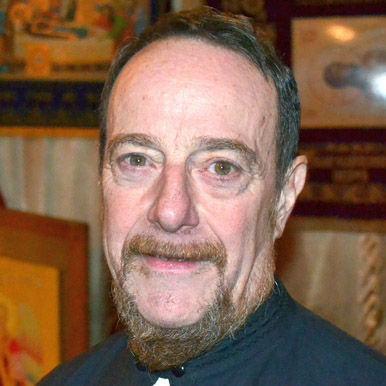The Gospel today from the 14th and 15th chapters of the Gospel of St Mark tells us what happened to Jesus Christ after the Crucifixion. A member of the Sanhedrin, the Governing Council of the Jews, Joseph of Arimathea “who was himself looking for the kingdom of God, took courage and went to Pilate and asked for the body of Jesus.” St John Chrysostom has pointed out that Joseph “had been concealing his discipleship; [but] now he became very bold, after the death of Christ. For neither was he an obscure person [but rather] highly distinguished, and as we see courageous. For he exposed himself to death, taking upon himself the [hostility] of all by his affection [for] Jesus.” St Ephrem the Syrian has pointed out that just as one man named Joseph looked after Holy Mary at the birth of Jesus Christ, so another Joseph looks after Jesus Christ at His death, So “this name receives the full reward for serving Him at His birth in the cave and for having served His corpse at the tomb.”
These two men named Joseph are models for us. Joseph looked after Holy Mary at the birth of Jesus Christ; and then Joseph continued to look after both Holy Mary and Jesus Christ for many years later. At the death of Jesus Christ, another Joseph from the Jewish village of Arimathea stopped hiding his commitment to Christ and told Pilate and many influential Jews that he was a follower of Jesus Christ. We can do the same: we can care for those whom the Lord sends to us—our families, our friends and at times strangers. We can declare our allegiance to Christ at the appropriate time when we have an opportunity to witness to others that being a Christian is the best way to live that offers each of us the Truth—Jesus Christ—and His Church.
In the fourth century, St Gregory Nazianzus, Bishop of Constantinople, theologian and preacher, linked what happened to Jesus after the Crucifixion to what happens to us after Lent. He preached: “Yesterday I was crucified with Christ; today I am glorified with Him. Yesterday I died with Him; today I am given life with Him. Yesterday I was buried with Him; today I rise again with Him.” In other words, if during our lives we suffer with Christ, we will be glorified with Him. If we die with Him, we will be given life with Him. If we are buried as believing Christians we will rise again with Him.
The simplicity with which Joseph of Arimathea buried Jesus Christ is also a model for the Church. St Bede has preached of how: “The vanity of the rich, who even in their graves cannot do without their riches, receives its condemnation from the simple and unassuming [burial] of the Lord. Hence indeed the custom of the Church was derived, that the sacrifice of the altar should not be commemorated by wrapping the elements [of the body and the blood of Christ] in silk, or any coloured cloth, but in linen; as the body of the Lord was buried in clean fine linen.” Origen has pointed out that this linen cloth “was much cleaner [after] the time it was used to cover Christ’s body than it had ever been before. For the body of Jesus retained its own integrity, even in death, so that it cleansed everything it touched and renewed even the new tomb that had been cut from rock.” Origen’s insight applies also to the altar on which the priest celebrates the Eucharist. In our celebration of the Eucharist as a community, both the altar and we ourselves are cleansed again and again; and we gain the power to clean what we touch by bringing Christ to others.
Many Church Fathers have reflected on this Gospel reading. Let’s look also at what St John Chrysostom preached in the fourth century about Holy Mary and Mary the mother of Joses and the apostle James, waiting beside the tomb of Jesus Christ. St John began by asking: “For what purpose do the two Marys wait beside [the tomb]? As yet they did not fully know His greatness. They had brought ointments. They were waiting at the tomb, so that if the madness of the civil authorities should relax, they might go and care for the body. Do you see these women’s courage? [Do you] see their depth of [caring]? {Do you] see their noble spirit in providing [ointments]? {Do you} see their noble spirit even to death?” To these many questions that St John posed, he responded simply, “Let us men imitate these women! Let us not forsake Jesus [Christ] in times of trial! These women exposed their lives so much for Him when He was dead; [and] they had spent so much [on precious ointments] for Him when He was alive. But we men … neither feed Him when hungry nor clothe Him when naked. Seeing Him begging, we pass Him by. And yet if we [men] might really behold Him in the neighbour, we would [give away] all our goods.” St John was far ahead of his time. Few men in the fourth century respected women as much as St John.
Clearly, the burial of Jesus Christ in the tomb by Joseph of Arimathea has much to teach us. St Matthew has pointed out in his Gospel that Pilate had agreed to a request to make the tomb secure “lest His disciples come and steal Him away.” As St John Chrysostom preached, and I quote: “Since the [tomb] was sealed, there could be no funny business. So then the proof of His resurrection has become incontrovertible [that is, not able to be disputed or doubted].... It is clear that He has risen,” preached St John.
Let us today remember the courage of Joseph of Arimathea, and how he trusted that Jesus was indeed the Messiah—the Christ. Joseph sought to serve Jesus by burying Him. Instead, Joseph proved to himself and to us that Jesus Christ could not be buried and forgotten, but would be remembered forever after His Resurrection and Ascension to His Father who is also our Father. Christ is risen! Indeed He is risen!

 Archpriest Gregory Hallam
Archpriest Gregory Hallam
 Fr. Emmanuel Kahn
Fr. Emmanuel Kahn